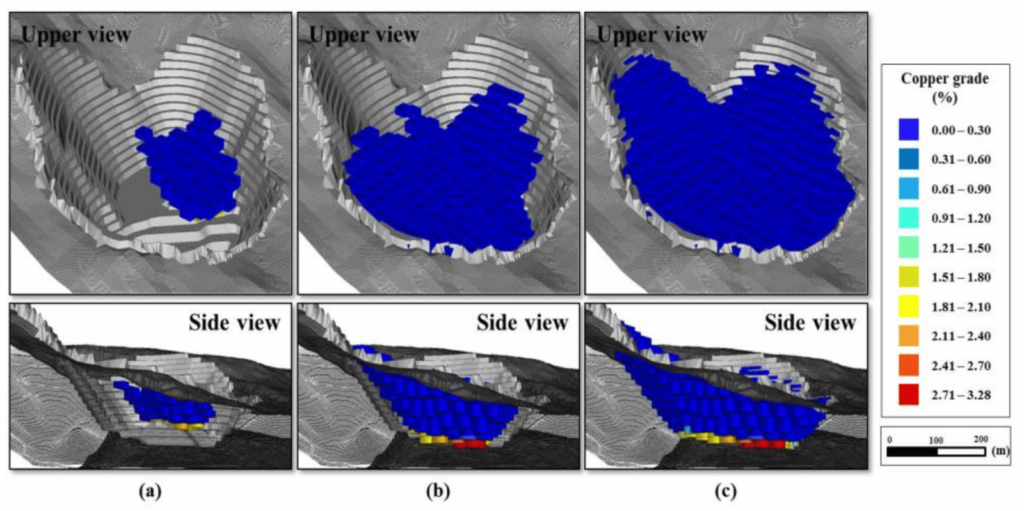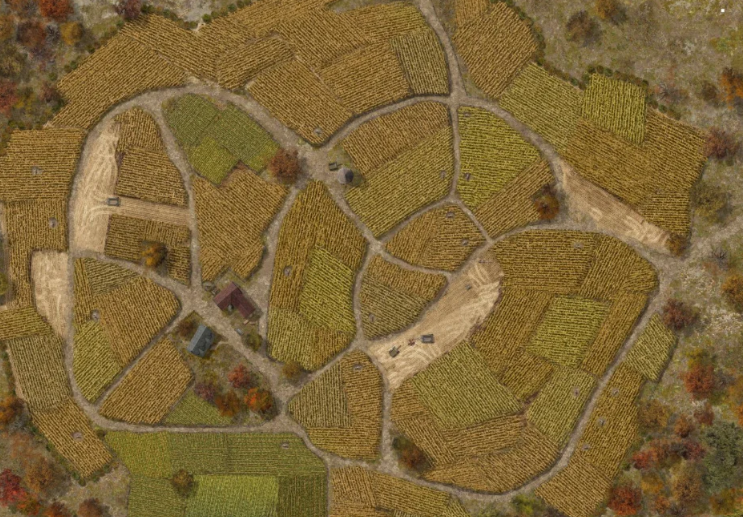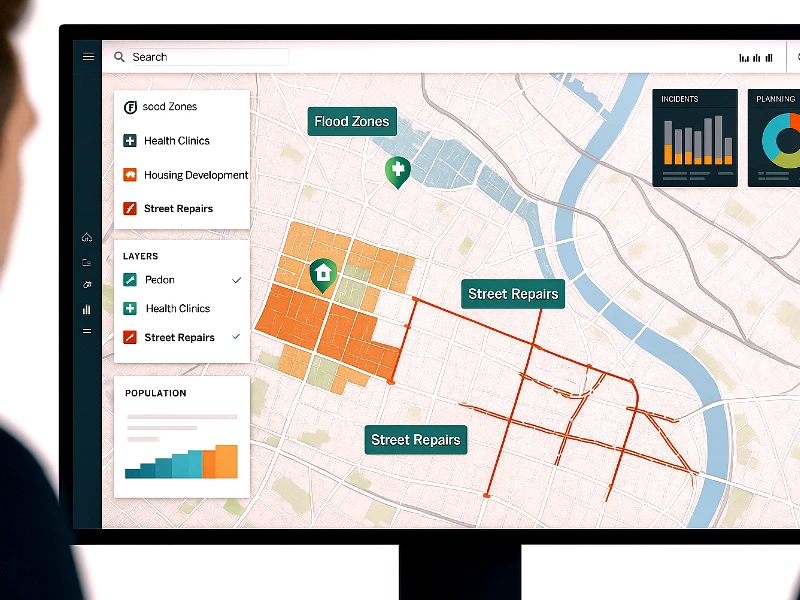What is GIS?
A Geographic Information System (GIS) is a computer-based platform used to capture, store, manipulate, and display geographic information. In the context of mining, GIS services in the mining sector help unlock critical insights hidden within vast land areas offering faster, smarter, and safer exploration. Information displayed on GIS systems may range from vegetation information to building and street information.
It helps in visual understanding and analysis of the data in order to identify relationships and patterns that are important to several mining processes. This brings an important factor that needs to be looked at, which is, spatial and non spatial data and information as a carrier and tool for decision making and analysis. Spatial data covers all the details of maps, satellite images and Global Positioning System (GPS) locations.
On the other hand, nonspatial data entails information about the spatial data including geological make-up, grade and/or ownership. Some functionalities that GIS possess include; spatial and statistical analysis, modelling, and geostatistical functionality that enable it to superimpose spatial and nonspatial data to develop multilayer data.
Looking to Optimize Your Mining Operations?
Utilize GIS Navigator’s services to enhance exploration efficiency, streamline operations, and improve safety measures.
📞 Schedule a Call | 📩 Email Us | 💼 Get a Quote Now
Importance of GIS in Mining
This multiple integration of data enabled management to look at multiple variables at one given time. It supports mining planning, identification, operations, environmental issues, and restoration finally. It is a very important tool to the mining industry offering applications that enhance precision, tractability, and efficacy.
These tools support GIS for mining operations across all phases from exploration and assessment to planning and closure. The ability to integrate geospatial and geological data allows mining teams to evaluate mineral-rich zones while ensuring compliance and operational safety.
Exploration and resource assessment are crucial application areas of GIS in mining. GIS also helps in showing the political structures of a country, natural resource deposits, and even likely prospects of mineral deposits. It also offers the potential for the construction of a new exploration target model which might help in future exploration of the area.
Applications of GIS in Mining
Today’s mines operate on data. Geospatial analytics for mining offers a powerful way to visualize, monitor, and plan extraction with reduced risk. Below are key applications of GIS that transform how modern mining functions.
GIS in Mining – Remote Sensing
Another important component that can be helpful in exploration is the application of models of Remote Sensing, Geophysical Data and Historical records of the various mining sites which offers research and analysis on the various site as well as detailed information regarding equipment.

GIS in Mining – Planning & Design

Secondly, the aspects of mine planning and design are also other futures of the mining industry which are benefited more by the GIS system. GIS systems that contain data on terrain, geology, and the environment are beneficial in site selection, and design of pit lay pits, waste dumps, and haul roads through spatial analysis tools.
Finally, models integrated with GIS facilitate volume and grade estimation and, at the same time, maximize accuracy.
GIS in Mining – Environmental Assessment
Moving on to environmental impact assessment. The mining industry has a profound impact on the environment and vice versa. The GIS system, therefore, provides mapping and monitoring of vegetation, water resources, and land use changes.

This helps further mitigation alongside predicting mining activities’ impact on ecosystems. With more focus on developing environmental regulations, the GIS system ensures compliance with current and changing environmental regulations through spatial documentation.
GIS in Mining – Operational Management
One of the core GIS services in the mining sector is real-time operational management. Real-time tracking of mining operations, machinery, personnel, and personnel makes it much easier to record incidents, equipment misplacement, and progress.

Moreover, ore transportation routes and stockpiles can be monitored to limit delays and ensure sufficient planning. Lastly, drones with installed GIS can help visualize mine conditions, serving as essential progress indicators.
GIS in Mining – Safety & Risk Management
GIS aids safety and risk management as it helps identify hazardous areas that are prone to landslides, subsidence, and flooding. While also providing a GIS-based emergency response, helping save lives and mitigating risks. With the use of historical accident data, safety can be further improved by instilling protocols and understanding how to deal with accidents in the most appropriate form. With geospatial analytics for mining, companies can build smarter risk profiles, assess terrain safety, and prepare incident response plans tailored to specific geolocations.

GIS in Mining – Rehabilitation & Post Mining Land Use
Lastly, GIS for mining operations also plays a key role in post-mining planning and land rehabilitation. Land wastage is a target that mining professionals often strive to achieve. Using GIS can achieve this as it plans and monitors mine closure activities while also restoring landscapes and providing evaluations about post-mining land use options.
By tracking progress in rehabilitation efforts over time, it can be ensured that there is minimal environmental degradation caused by mining.
Multiple technologies support the use of GIS in mining. Idle GIS even provides various needed services with technological support, and the impact of GIS in mining can be severely increased. Starting with the integration of remote sensing LiDAR and satellite imagery.
Moving on to the use of 3-D modeling and spatial data visualization for subsurface analysis, the most integral part of modern technological usage is implementing AI and machine learning for predictive analysis. These not only increase the overall efficiency but also provide accuracy and further accuracy and ease in all phases of mining operations.

From exploration to closure, GIS services in the mining sector offer a full suite of solutions. Whether it’s resource evaluation, predictive planning, or rehabilitation tracking, GIS for mining operations enhances every step with clarity, precision, and control. These benefits range from improved decision-making with accurate and integrated spatial data that enables es. Icing companies to analyze complex spatial relationships, such as the location of mineral-rich zones, facilitates better site selection for exploration and excavation to enhance safety and environmental compliance in an essential aspect in ensuring that the industry maintains durability in terms of employment and there is minimal environmental degradation which is extremely important for suitability.
To continue, cost-effective savings by optimized resource allocation and planning is another key advantage that is done through the planning of efficient mine layouts, haul layouts, and stockpile locations while keeping operational costs at a low, alongside increased productivity that is a result of real-time monitoring that serves to be effective in ensuring maximum capability and reliability on employees, while providing ample autonomy.
Through better analyses of operation bottlenecks and providing actionable insights for performance improvements.
Need Accurate Mapping & Analysis for Your Mining Projects?
GIS Navigator provides precise mapping and data analysis to support informed decision-making in mineral exploration and mine management.
📞 Schedule a Call | 📩 Email Us | 💼 Get a Quote Now
GIS In Mining – Challenges & Limitation
However, multiple challenges and limitations that arise with the use of GIS in mining operations should be identified. These barriers, therefore, may cause poor uptake and implementation if not well dealt with.
High Initial Costs
One of the main reasons GIS has not yet been extensively adopted across the mining industry, especially among SMEs, is the high initial costs associated with developing a powerful GIS framework.
This includes software licensing costs, faster and more efficient hardware devices, and satellite or remote sensing information.
Specialized Training Requirements
Geologists, engineers, and other personnel need specialized training in GIS tools. This training takes time and money, so the adoption process is costly.
Maintenance and upgrades of GIS systems are long-term expenditures that periodically increase operational costs. This means there is a considerable dependence on accurate and up-to-date spatial data, which is a realistic concern in practice.
GIS depends greatly on quality, accurate, and up-to-date geographic information. The sources of data and the quality of data collected may also be a problem, resulting in wrong analysis and wrong decisions.
Long-Term Maintenance & Upgrade Costs
Gathering accurate data may take a lot of time and be costly; for instance, using remote sensing or through field samples where the terrain is hard to access. Space changes are often due to seasons, environmental variations, and human activity, which may make the existing spatial data outdated and require frequent updates.
Some mining industries still use old systems that cannot be supported by GIS software. The changeover to GIS demands conversion and computerization of data, which can be quite time-consuming.
Lack of an acceptable amount of storage space or processing power can help to work fully with GIS software and tools, especially when using additional functions like 3D and real-time tracking. Solving these problems is crucial to realizing the opportunities of GIS in increasing the effectiveness and efficiency of sustainable processes.
Future Trends
GIS in mining has already revolutionized how the industry competes. As for future trends already visible today, GIS applications can expect breakthroughs based on new technologies and practices that use new approaches to organization and optimization of operations and enhanced security.
Power of UAVs
The future uses may entail real-time strategies for exploring the potential of targeted sites based on AI-generated probabilities. The Expansion of UAVs (Drones) as Aerial Sensors Drones, also known as unmanned aerial vehicles (UAVs), are fast changing the way spatial data is gathered in mining.
Due to high-definition cameras and LiDAR sensors mounted on the drones, the terrain of the minefield and the monitoring of the sites are very effective. It lets the aerial data be incorporated into the GIS systems to produce precise 3D maps in the mining zones for efficient planning and tracking. It is possible to anticipate future improvements that will allow drones to conduct real-time surveillance on the more dangerous sections of the mine that would involve risky exploration by human beings.
Real World Examples
Rio Tinto, one of the world’s largest mining companies has been using GIS for its operational management to a great extent. Exploration is one of the uses of GIS by the company, other uses include effects of the environment on the company and also transport of the minerals.
A typical example is the application of GIS in integration with the auto-haulage technology where use of spatial information is made to enhance the physical arrangement in mines and the extent of fuel utilized. Satellite imagery coupled with geochemical data has been applied in the use of GIS technology in locating new gold deposits in Africa. This has provided mining companies with a much more precise way of exploring, lowering the costs and raising the hit ratio.
Extract More, Waste Less – GIS Navigator Simplifies Mining!
Make informed decisions, cut costs, and minimize environmental impact with accurate mapping.
📞 Schedule a Call | 📩 Email Us | 💼 Get a Quote Now
GIS in Mining – The GIS Navigator Advantage
Discover how The GIS Navigator Advantage can revolutionize your mining operations. From improving resource management to optimizing decision-making with precise spatial data, our solutions are tailored to drive efficiency and sustainability.
Don’t let challenges hold your operations back—embrace innovation and transform the way you work. Contact us today for free consultation and quote to explore how GIS can empower your mining projects for a more productive and sustainable future!



